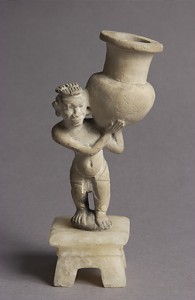 The copious use of lead in ancient (and even fairly recent) makeup is generally not considered to have been a great call, healthwise. Lead is toxic to many of our organs and to our nervous system, so you wouldn’t think slathering it all over your eyes in that typical Egyptian cat-shape could be good for you.
The copious use of lead in ancient (and even fairly recent) makeup is generally not considered to have been a great call, healthwise. Lead is toxic to many of our organs and to our nervous system, so you wouldn’t think slathering it all over your eyes in that typical Egyptian cat-shape could be good for you.
Analytical chemists at the French National Center for Scientific Research (CNRS) and the Louvre have examined some of the eyeliner from the Louvre collection and found two lead salts not found in nature which means the Egyptians actually took the considerable amount of time and trouble to synthesize these compounds to add them to their kohl. They aren’t glossy and don’t add any color advantage, so why bother?
To see if the lead might confer any health benefits, Amatore, Walter, and colleagues added lead salts to human skin cells called keratinocytes, which were grown in the lab. The researchers hypothesized that the lead would stress the cells and cause them to make hydrogen peroxide, nitric oxide, and other compounds involved in the body’s immune response. And indeed, cells treated with lead began pumping out more nitric oxide than did control cells, the team reports online in Analytical Chemistry.
Amatore says that nitric oxide sets off a series of biochemical processes in the body that ultimately send immune cells called macrophages to the site of infection, where they engulf invading organisms. That’s probably not what’s happening in keratinocytes, says immunologist Martin Olivier of McGill University in Montreal, Canada, who was not involved in the study. It’s unlikely that macrophages or other immune cells would exit the body and burst through the skin to fight off infectious agents at the surface, he notes. Instead, nitric oxide released by keratinocytes could directly kill eye-disease-causing bacteria on the skin or near the eye by breaking down a bacterium’s structure or DNA. Another plausible scenario, says Olivier, is that lead itself could directly stimulate immune cells already present in the eyelid.
Contemporary writings support the idea that the nitric oxide was intentionally included to combat eye disease. Ancient manuscripts describe lead salts being used to treat eye disease, scars, and discolorations so it seems those dramatic cat’s eye looks may have been intentionally medicinal as well.
Jennifer Weuve of Rush University Medical Center cautions that Egyptians also had a shorter lifespan than ours, so perhaps any long-term consequences to the lead in their makeup might be obscured by their earlier deaths. It may not have been so much good for them as not bad enough to noticeably harm them in the few decades that had to live.